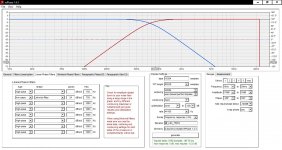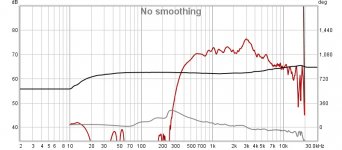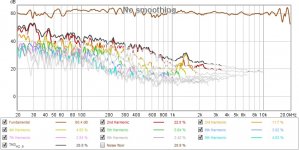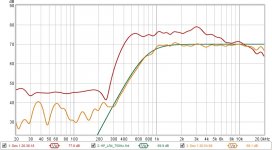Very nice looking setup
Did you apply any kind of LF boost? It kind of hard to tell from the graph but it looks like your around 6db down at 30hz?
hi Cooljazz,
Yes, I use (a lot) of LF boost, if I remember correct about 25dB, the -3dB is at 90Hz, measured close to the dustcap of the woofer
P
You seem to have great conditions to perform proper measurements.
What about following this procedure, so you can module your crossover in VituixCAD?
- How to make quasi-anechoic speaker measurements/spinoramas with REW and VituixCAD | Audio Science Review (ASR) Forum
hi Neo,
Measuring outside does help, but I got very frustrated the first attempt by several reasons:
- too much wind, screwed everything below 100Hz
- birds, a large number of them were screaming in the garden of the neighbors
- another neighbor decided it was a good idea to use his chainsaw
- in the end I got cold....
Setting up the stuff to support the speaker and getting those heavy speakers on top is quite a hassle, at that moment I hated having build these big things.
Yes, I did see this methode, I used the basics.
I might dive into this a bit more, If only to create those nice looking spinorama's.
regards, Peter
Hi petervv,
can you please clarify the crossover and its implication on power?
Per your post # 12, the crossover frequency is 750 Hz. If you equalized the HF108 1 octave away from that, the frequency is 375 Hz, and another octave is 187.5 Hz.
Looking at the HF108 data sheet, it appears that you had to apply ~ 20 dB gain at 375 Hz and ~ 30+ dB at 187.5 Hz.
Given that the Minimum Crossover frequency is 1.3 kHz, and you are using 100W amplifier per your post #1, even with a crossover slope of 24 dB/octave, are you not worried about destroying the HF108?
Or, am I missing something?
Kindest regards,
M
hi M,
You're not missing something, but the spec of Faital is for high level PA.
I got inspired by this thread of forum member Legis, he is using HF108 in a very large horn with a crossover at 600-700Hz:
"Shadow of The Colossus" build thread
Below is the response of my HF108+horn, it runs strongly until about 500Hz.
At low frequencies reaching Xmax resulting in too much distortion will limit the maximum level.
At this moment I have the soft limiter of the tweeter amp at 10W.
I cannot make calibrated measurements, but to my ears the speakers go plenty loud without any stress.
Below is a distortion graph from REW, this was taken at relatively low level.
I don't think this is a very reliable measurement because of the high noise floor outside, but it does show nothing terribly wrong is happening.
kind regards, Peter
Attachments
Either coincidental or you have built yourself a beast of a speaker! Looks very nice!i get a calculated delay of 666us
petervv ... you definitely can run that woofer up higher. (1)khz is not an issue at all. If need be, even a bit higher is still fine. I wouldn't be using that much EQ in the crossover region, if any.
This is a good guide to time alignment of drivers.
Time alignment
This is a good guide to time alignment of drivers.
Time alignment
Applying the Grimm Audio WP does not always make sense, as Mefistofelez pointed out correctly with the ridiculous boost needed for HF108 to confirm this method. My suggestion for you is to equalize for flatness without this boost around crossover frequency. Then, generate LR4 target slopes with rephase and import them to you working REW measuring set. Usually, the target filter generated with rephase is set to 0dB SPL, adjust its level in REW to align it with your drivers passband output. Now, you can observe if the electronic LR4 filter actually translates into an acoustic LR4 slope, the latter being of sole importance. Only after you ensured with measurements and adapting the Hypex filters to the target LR4 slopes after measuring their acoustic effect with REW, you can be sure that your speakers run on a LR4 crossover at the intended xo frequency. If you achieved this, summation is always perfect with right delay and you can then easily find the correct delay because it must result in a very deep notch if one driver is inverted. I doubt your current settings are correct, because the physical offset does seem to be a bit much. Then again, I might be wrong.
Hi petervv,
thank you for your reply.
As I understand it, and I may, of course, be wrong, the reason for the one or two octave flat equalization is to avoid the driver(s) phase change due to its the magnitude roll-off.
Provided that some of the smart people confirm my understanding, since you are using digital signal processing (DSP), could you not just use finite impulse response (FIR) filter(s) to correct the phase?
The other issue I wonder about: If you limit the power to the HF108 to 10 W, are you really equalizing the response? Let us say that you are listening on average at 0.312 W. The 10 W is just 15 dB increase, and as estimated, you need 20 dB or 30+ dB respective.
Please, do understand that I am not trying to criticize your design, I am just trying to understand.
Kindest regards,
M
thank you for your reply.
As I understand it, and I may, of course, be wrong, the reason for the one or two octave flat equalization is to avoid the driver(s) phase change due to its the magnitude roll-off.
Provided that some of the smart people confirm my understanding, since you are using digital signal processing (DSP), could you not just use finite impulse response (FIR) filter(s) to correct the phase?
The other issue I wonder about: If you limit the power to the HF108 to 10 W, are you really equalizing the response? Let us say that you are listening on average at 0.312 W. The 10 W is just 15 dB increase, and as estimated, you need 20 dB or 30+ dB respective.
Please, do understand that I am not trying to criticize your design, I am just trying to understand.
Kindest regards,
M
petervv ... you definitely can run that woofer up higher. (1)khz is not an issue at all. If need be, even a bit higher is still fine. I wouldn't be using that much EQ in the crossover region, if any.
This is a good guide to time alignment of drivers.
Time alignment
hi Puppet,
Yes I know I can run the woofer higher, but the point of using such a big horn is of course to crossover as low as possible, outside of the ears most critical area.
regards, Peter
Applying the Grimm Audio WP does not always make sense, as Mefistofelez pointed out correctly with the ridiculous boost needed for HF108 to confirm this method. My suggestion for you is to equalize for flatness without this boost around crossover frequency. Then, generate LR4 target slopes with rephase and import them to you working REW measuring set. Usually, the target filter generated with rephase is set to 0dB SPL, adjust its level in REW to align it with your drivers passband output. Now, you can observe if the electronic LR4 filter actually translates into an acoustic LR4 slope, the latter being of sole importance. Only after you ensured with measurements and adapting the Hypex filters to the target LR4 slopes after measuring their acoustic effect with REW, you can be sure that your speakers run on a LR4 crossover at the intended xo frequency. If you achieved this, summation is always perfect with right delay and you can then easily find the correct delay because it must result in a very deep notch if one driver is inverted. I doubt your current settings are correct, because the physical offset does seem to be a bit much. Then again, I might be wrong.
hi Sheeple,
Thanks for your valid suggestions, you're completely correct that the end result must be an acoustical LR4 filter. I have read somewhere that it's not possible to calcultate biquads in REW or rephase because somehow Hypex (Bruno) did not use standard biquads, I will try to find this posting, I think it was on ASR.
My original delay was certainly not correct, yesterday I programmed 661us and that was a major improvement in sound quality, did not perform any measurements yet.
It's obvious this is just the start of my learning curve to create the optimal filters, but they sound ridiculously good already.
kind regards, Peter
Hi petervv,
thank you for your reply.
As I understand it, and I may, of course, be wrong, the reason for the one or two octave flat equalization is to avoid the driver(s) phase change due to its the magnitude roll-off.
Provided that some of the smart people confirm my understanding, since you are using digital signal processing (DSP), could you not just use finite impulse response (FIR) filter(s) to correct the phase?
The other issue I wonder about: If you limit the power to the HF108 to 10 W, are you really equalizing the response? Let us say that you are listening on average at 0.312 W. The 10 W is just 15 dB increase, and as estimated, you need 20 dB or 30+ dB respective.
Please, do understand that I am not trying to criticize your design, I am just trying to understand.
Kindest regards,
M
hi mefistofelez,
I think you might understand this wrong, let's say I equalize the response flat to 100Hz and then apply a LR4 at 750hz.
Response will be down 24dB at 375Hz, 48Hz down at 187.5Hz etc, 74dB down at 93.75Hz etc.
Equalizing the response flat 2 octaves below the crossover is just 'virtual', it's a way to create an acoustical LR4 filter with a standard LR4 filter.
kind regards Peter
Hi petervv,
thank you for your reply. The reason for my continuing comments is that once the weather permits measurement of my low-frequency enclosure, I will be facing a design of a cross-over.
I understand that you are aiming for an acoustical LR4, so you need to have a correct phase and be clear of the natural roll-off of the driver, at least for a pre-determined frequency and magnitude interval. However, I do not understand the term "virtual" equalization.
This is my understanding of the issue. Let us say that the driver's roll-off starts at f1=900 Hz and its slope 12 dB/octave. If your LR4 is applied at f2=1000 Hz, then the acoustic slope will initially be the slope of the LR4, i.e., 24 db/octave until the 24 dB/octave slope intersects the 12 dB/octave slope, wherein the acoustic slope becomes 36 dB/octave. This will, of course be true for any combination of f1 and f2 for f1 < f2.
Now, if one equalizes the driver's roll-off so that it starts at f3 = 0.5*f1 (one octave), the intersect point (for the LR4 applied at f2=1000Hz), will be at lower frequency and lower magnitude than in the initial example of f1=0.9*f2.
Therefore, to satisfy the later, the equalization must be "real", in the sense that one must apply power to the driver below the frequency of f1.
Where is the error in my understanding?
Kindest regards,
M
thank you for your reply. The reason for my continuing comments is that once the weather permits measurement of my low-frequency enclosure, I will be facing a design of a cross-over.
hi mefistofelez,
I think you might understand this wrong, let's say I equalize the response flat to 100Hz and then apply a LR4 at 750hz.
Response will be down 24dB at 375Hz, 48Hz down at 187.5Hz etc, 74dB down at 93.75Hz etc.
Equalizing the response flat 2 octaves below the crossover is just 'virtual', it's a way to create an acoustical LR4 filter with a standard LR4 filter.
kind regards Peter
I understand that you are aiming for an acoustical LR4, so you need to have a correct phase and be clear of the natural roll-off of the driver, at least for a pre-determined frequency and magnitude interval. However, I do not understand the term "virtual" equalization.
This is my understanding of the issue. Let us say that the driver's roll-off starts at f1=900 Hz and its slope 12 dB/octave. If your LR4 is applied at f2=1000 Hz, then the acoustic slope will initially be the slope of the LR4, i.e., 24 db/octave until the 24 dB/octave slope intersects the 12 dB/octave slope, wherein the acoustic slope becomes 36 dB/octave. This will, of course be true for any combination of f1 and f2 for f1 < f2.
Now, if one equalizes the driver's roll-off so that it starts at f3 = 0.5*f1 (one octave), the intersect point (for the LR4 applied at f2=1000Hz), will be at lower frequency and lower magnitude than in the initial example of f1=0.9*f2.
Therefore, to satisfy the later, the equalization must be "real", in the sense that one must apply power to the driver below the frequency of f1.
Where is the error in my understanding?
Kindest regards,
M
Last edited:
hi Sheeple,
Thanks for your valid suggestions, you're completely correct that the end result must be an acoustical LR4 filter. I have read somewhere that it's not possible to calcultate biquads in REW or rephase because somehow Hypex (Bruno) did not use standard biquads, I will try to find this posting, I think it was on ASR.
My original delay was certainly not correct, yesterday I programmed 661us and that was a major improvement in sound quality, did not perform any measurements yet.
It's obvious this is just the start of my learning curve to create the optimal filters, but they sound ridiculously good already.
kind regards, Peter
here's the link to ASR: Measuring response curve in the target room for designing active crossovers and filters | Audio Science Review (ASR) Forum
'DS23man' is an external consultant and beta tester for Hypex
petervv,
nice to learn some more about the slopes utilized in the DSP of Hypex plate amps, thanks. Still, this got nothing to do with what I was suggesting
Please download the software rePhase - Official Site - Free FIR filtering tool first. You can create .frd files that can be imported to REW and with rephase, you can create plain text book LR4 filters. Together with REW, this means you can have an ideal LR4 high pass and low pass curve in REW as targets while you are measuring individual driver response. This is why it does not matter if Mr. Putzey decided for a certain slope Q with HPX software. You can simply track what your inputs in HPX do and what an ideal LR4 filter should do at a certain XO frequency, and you can manually adjust your filters in HPX until they match. Remember that this is sufficient, because the only filter that matters is the actual acoustic.
For example, my speaker's compression drivers run on a digital LR2 filter, but because the compression driver is already on its performance edge at my chosen XO frequency, this is sufficient to achieve acoustic LR4 filter.
As a starter, I generated LR4 HP and LP for a 750 crossover frequency. You can import the files to REW and see if your driver's measurements track these curves. If not, you have to work over the filters. If you need other frequencies, help yourself with rephase. Also, do not forget to adjust the SPL of the target curves, as already suggested above. They will often be invisible because they reside at 0 dB SPL. For this, in REW click on "Controls" in the right top corner and add a common SPL offset for both target curves that match the level at which you are doing your measurements, i.e. 70 dB SPL. You can also hit "Add to the data", then, they will stay at this level the next time.

nice to learn some more about the slopes utilized in the DSP of Hypex plate amps, thanks. Still, this got nothing to do with what I was suggesting
Please download the software rePhase - Official Site - Free FIR filtering tool first. You can create .frd files that can be imported to REW and with rephase, you can create plain text book LR4 filters. Together with REW, this means you can have an ideal LR4 high pass and low pass curve in REW as targets while you are measuring individual driver response. This is why it does not matter if Mr. Putzey decided for a certain slope Q with HPX software. You can simply track what your inputs in HPX do and what an ideal LR4 filter should do at a certain XO frequency, and you can manually adjust your filters in HPX until they match. Remember that this is sufficient, because the only filter that matters is the actual acoustic.
For example, my speaker's compression drivers run on a digital LR2 filter, but because the compression driver is already on its performance edge at my chosen XO frequency, this is sufficient to achieve acoustic LR4 filter.
As a starter, I generated LR4 HP and LP for a 750 crossover frequency. You can import the files to REW and see if your driver's measurements track these curves. If not, you have to work over the filters. If you need other frequencies, help yourself with rephase. Also, do not forget to adjust the SPL of the target curves, as already suggested above. They will often be invisible because they reside at 0 dB SPL. For this, in REW click on "Controls" in the right top corner and add a common SPL offset for both target curves that match the level at which you are doing your measurements, i.e. 70 dB SPL. You can also hit "Add to the data", then, they will stay at this level the next time.

Attachments
petervv,
nice to learn some more about the slopes utilized in the DSP of Hypex plate amps, thanks. Still, this got nothing to do with what I was suggesting
View attachment 999587
hi Sheeple,
Thanks for your explanation.
I tested you proposal today, using your 750Hz LR4 file, see picture below.
All measurements are in room with a 5ms window, measured about 1m from the horn.
First measured the tweeter without filter, then started entering the filters en eq in the Hypex software and loading each iteration into the plate amp and measure again.
Turned out that if I put a 750Hz LR4 in, I needed almost no extra eq around the crossover area to get a nice fit to the target curve.
After that i did some eq to get the 3kHz down, and some shelving to lift the response above 10kHz.
(The curves below 300Hz are not reliable, this is mostly background noise)
After this I put the mic around 3m from the speaker to find the optimal delay, inverted the woofer and started varying the delay in HFD, deepest notch was quickly found.
I am now listening to this filter and it definitely sounds better than my previous efforts with a lot of eq, it sounds less stressed.
I can't hear where the crossover frequency is, and there's more space in the music.
I probably will tweak the HF a bit, it a bit laid back now.
What have I learned:
1. This is a great community with very experienced and knowledgeable people who are willing to help others, thank you!
2. I don't understand how to get reliable measurements with correct timing in HFD
3. REW is a great straight forward and reliable measurement tool
4. I really love these Hypex Fusion amps, great flexibility and great sound.
5. It's a trap to try to remove every ripple in the response with eq.
6. Big speakers really do sound big, I love it 🙂
kind regards, Peter
Attachments
Hello Peter,
good to see this worked out for you!
It is cold in Germany by now, and so I think it is in the Netherlands, but here is some even more advanced approach in this tread that I suggest to you, maybe for the next spring:
New active Satori Textreme
The description of the relevant procedure stretches at least until around posting #147.
How is your LF filter and would you like to show us both the filters working together?
Greetings
M
good to see this worked out for you!
It is cold in Germany by now, and so I think it is in the Netherlands, but here is some even more advanced approach in this tread that I suggest to you, maybe for the next spring:
New active Satori Textreme
The description of the relevant procedure stretches at least until around posting #147.
How is your LF filter and would you like to show us both the filters working together?
Greetings
M
There is a complet tutorial for mesured and creating filtering for DIY speakers with Fusion Hypex?
Really cool project! When you have tested that I would like to suggest an other Q and that is 0,5 for your LT. Aim for the same Fsc. Please report back on your experience.The volume of the box is about 110 liter, according Winisd this will give me a Fsc of 64Hz with a Q=0.58.
With a Linkwitz transform is simple to bring this to 30Hz with a Q=0.707 and still go plenty loud with 250W (and stay within Xmax)
//
je do you do a linkwitz transformation into an active crossover? In this specific case of 15pr400 in à 110 liters sealed box, it s just by booster the bass with EQ ?
Use a lo-shelf filter to boost the low end. Most are 6db or 12db per octave and the target frequencies are the F3 of the filter, usually. This filter is also an aid to baffle step compensation. Maybe "12db/120hz/+5 gain" to get you started.je do you do a linkwitz transformation into an active crossover? In this specific case of 15pr400 in à 110 liters sealed box, it s just by booster the bass with EQ ?
Then choose a lo-cut frequency (basically a high pass). Say 40-45hz and apply a Q to that filter. I'd use a Q of 0.80 for starters. Increasing the Q will increase lo-cut gain but a steeper cut off slope will result. Increasing gain on the lo-shelf filter (above) will also boost the lo-cut response (preferred).
This is what I've done with this driver (15pr400).
- Home
- Loudspeakers
- Multi-Way
- New project: 15PR400+HF108+BigOldRadial+HypexFA123



